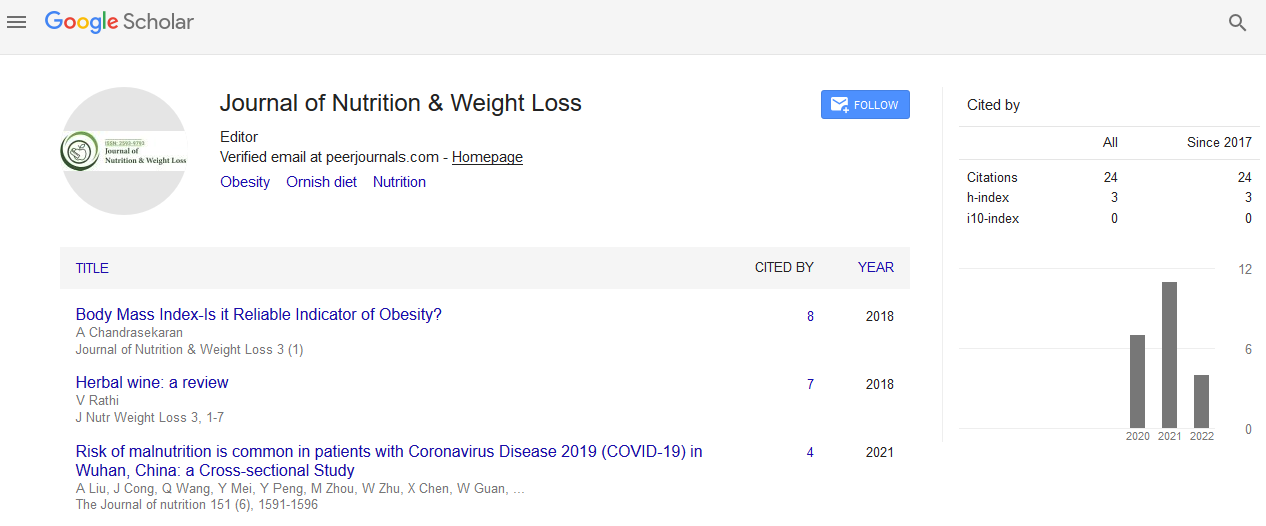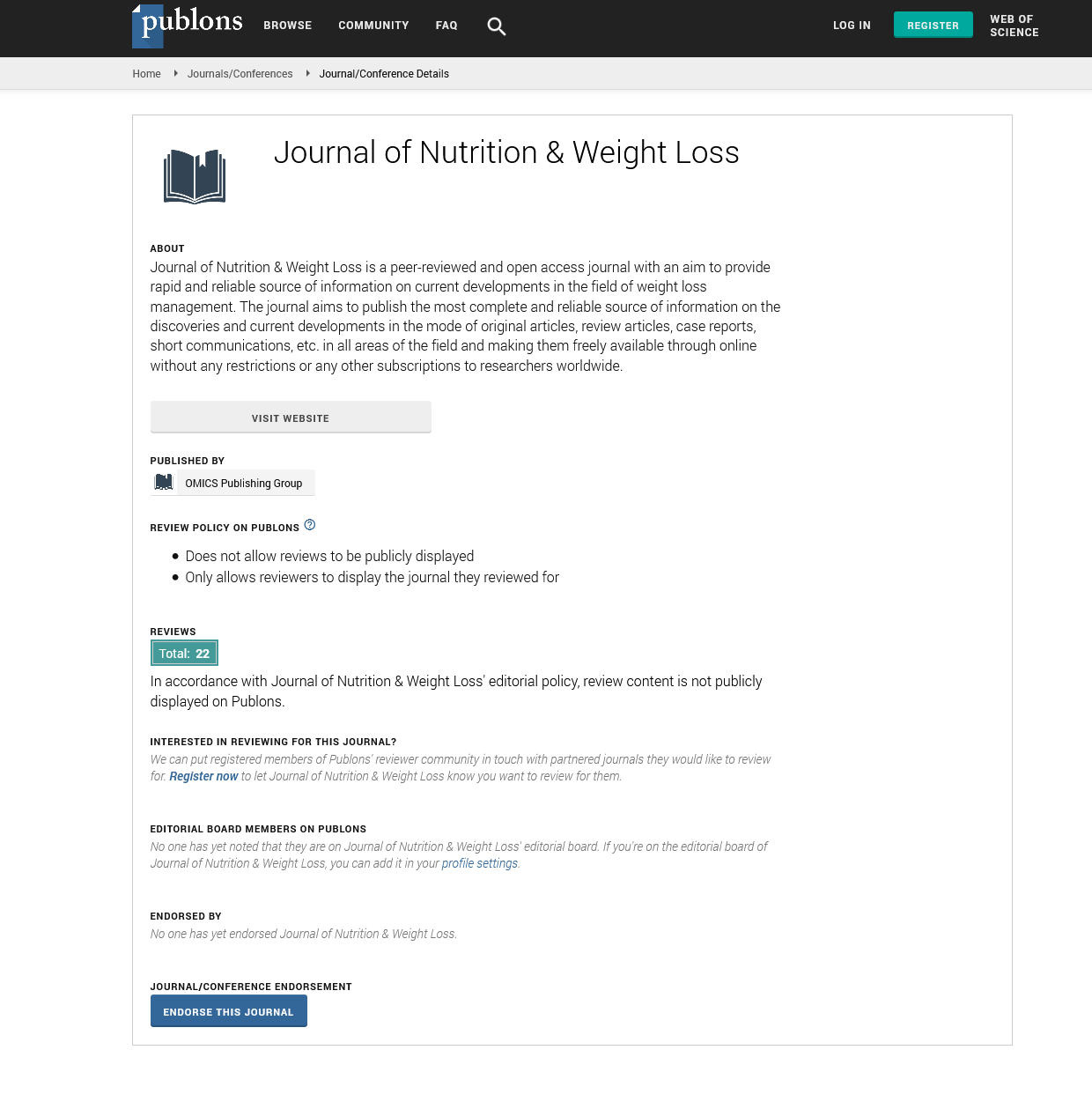Indexed In
- RefSeek
- Hamdard University
- EBSCO A-Z
- Publons
- Euro Pub
- Google Scholar
Useful Links
Share This Page
Journal Flyer

Open Access Journals
- Agri and Aquaculture
- Biochemistry
- Bioinformatics & Systems Biology
- Business & Management
- Chemistry
- Clinical Sciences
- Engineering
- Food & Nutrition
- General Science
- Genetics & Molecular Biology
- Immunology & Microbiology
- Medical Sciences
- Neuroscience & Psychology
- Nursing & Health Care
- Pharmaceutical Sciences
Short Communication - (2023) Volume 8, Issue 1
The Role of S1PRs in Immune Cell Migration and Weight Regulation
Chunying Anam*Received: 21-Feb-2023, Manuscript No. JNWL-23-20965; Editor assigned: 24-Feb-2023, Pre QC No. JNWL-23-20965(PQ); Reviewed: 14-Mar-2023, QC No. JNWL-23-20965; Revised: 21-Mar-2023, Manuscript No. JNWL-23-20965(R); Published: 28-Mar-2023, DOI: 10.35248/2593-9793.23.8.163
Description
Immune cell migration into the CNS could provide an explanation for the pathogenesis of Multiple Sclerosis (MS). After crossing the blood-brain barrier into the Central Nervous System (CNS) and becoming activated by Antigen-Presenting Cells (APCs), peripheral auto-reactive T and B lymphocytes cause inflammation, demyelination, and neurodegeneration. Sphingosine-1-phosphate receptors on immune cells are bound by this substance, which causes the immune cells to become trapped in nearby lymph nodes [1]. This can decrease the migration of immune cells into the CNS tissue. S1p modulator medicines could induce broad variety of side effects such as cardiac complication, raised blood pressure, and elevated liver enzymes, weariness, macular edema, leukopenia, increased risk of infection and cancers [2-4].
Since that S1PRs are abundantly expressed in the hypothalamus, Fingolimod probably has a noticeable impact on hypothalamic functions like hunger and body weight. They were also questioned about any additional negative effects they may have suffered from taking Fingolimod. Patients who have previously experienced changes in appetite after taking Fingolimod underwent appropriate exams. Also, statistical analyses were carried out with SPSS 22.0 for Windows, and all data were presented as mean+SD, percentage, and count for frequencies [5]. A clinically significant unintentional weight loss is one that occurs over a period of 6 to 12 months and involves a Loss of 4.5 kg, or 5% of Body Weight (IWL). Severe weight loss is defined as losing more than 10% of body weight over a period of six months or more than 20% over a period of twelve months.
Other potential causes of weight loss, including mental health issues, gastrointestinal conditions, cancer, etc., were ruled out [6]. The Sphingosine 1-Phosphate Receptor 1 (S1PR1) is the most affected of the five known subtypes of S1PRs by Fingolimod-phosphate. It can also bind to S1PR3, S1PR4, and S1PR5, though. Fingolimod key function in managing MS is to limit lymphocyte egress from lymph nodes to the CNS and down-regulate S1P receptors on lymphocytes. However, Fingolimod intake may also have an adverse effect on other undesired bodily functions, such as those of the hypothalamus, given the wide range of tissue and cell types expressing S1PRs. In the ventromedial region of the hypothalamus, close to the median eminence, is where the Accurate Nucleus of the Hypothalamus (ARH) is situated [7].
The ARH can therefore detect metabolic and hormonal signals from the peripheral blood circulation and integrate them with neural impulses because it is richly supplied by fenestrated capillaries [8,9]. S1PR1 is also mostly expressed by anorexigenic neurons rather than orexigenic neurons in the accurate nuclei. Rats' third ventricles were given S1PR, and research has shown that S1PR can decrease food intake while increasing energy expenditure and body temperature. Moreover, the results of intravascular and intraperitoneal S1p administration are comparable [10].
One novel medical device to change eating behavior is an intraoral splint that reduces oral capacity by 25% and alters eating speed without preventing users from eating. This device was tested in a prospective study with six obese patients with highrisk cardiovascular profile who received the device for 4 to 8 weeks and achieved a significant and sustained weight loss over two years. The device was used only during meals and patients were advised not to count calories or follow any other diet. Two Janus kinase 2 (JAK2) proteins are linked with the intracellular portion of S1PR1. Once S1PR binds to S1PR1, JAK2 is phosphorylated, which causes Signal Transducer and Activator of Transcription 3 (STAT3) to phosphorylate and create a homodyne. S1PR1 mRNA levels are then raised as a result of STAT3 homodyne's impact on Proopiomelanocortin (POMC) promoters and transcription factors.
Conclusion
As a result, it's crucial to send patients taking this medication to a nutritionist and urge them to pay closer attention to their diet in order to avoid potential Fingolimod-related side effects like unintentional weight change. Appetite suppression followed signals from the PVN that travelled through secondary effector neurons to higher cortical centres. The aforementioned pathway (leptin-melanocortin pathway) is thought to represent the mechanism by which S1PR reduces appetite; however S1PR signaling causes STAT3 to be phosphorylated more powerfully and persistently.
References
- Fuleihan GE. Vitamin D deficiency in the Middle East and its health consequences for children and adults. Clinic Rev Bone Miner Metab. 2009;7(1):77-93.
[Cross Ref] [Google Scholar] [Pub Med]
- Holick MF. Vitamin D status: measurement, interpretation, and clinical application. Ann Epidemiol. 2009;19(2):73-78.
[Cross Ref] [Google Scholar] [Pub Med]
- Mithal A, Wahl DA, Bonjour JP, Burckhardt P, Dawson-Hughes B, Eisman JA, et al. Global vitamin D status and determinants of hypovitaminosis D. Osteoporos Int. 2009;20:1807-1820.
[Cross Ref] [Google Scholar] [Pub Med]
- DeLuca HF. Evolution of our understanding of vitamin D. Nutr Rev. 2008;66(2):73-87.
[Cross Ref] [Google Scholar] [Pub Med]
- Holick MF. Vitamin D deficiency. N Engl J Med. 2007;357(3):266-281.
[Cross Ref] [Google Scholar] [Pub Med]
- Holick MF. Vitamin D: a D-Lightful health perspective. Nutr Rev. 2008;66(2):182-194.
[Cross Ref] [Google Scholar] [Pub Med]
- Naeem Z. Vitamin d deficiency-an ignored epidemic. Int J Health Sci. 2010;4(1).
- Giovannucci E, Liu Y, Hollis BW, Rimm EB. 25-hydroxyvitamin D and risk of myocardial infarction in men: a prospective study. Arch Intern Med. 2008;168(11):1174-1180.
[Cross Ref] [Google Scholar] [Pub Med]
- Sadat-Ali M, AlElq A. Osteoporosis among male Saudi Arabs: a pilot study. Ann Saudi Med. 2006;26(6):450-454.
[Cross Ref] [Google Scholar] [Pub Med]
- Holick MF. Sunlight and vitamin D for bone health and prevention of autoimmune diseases, cancers, and cardiovascular disease. Am J Clin Nutr. 2004;80(6):1678S-1688S.
[Cross Ref] [Google Scholar] [Pub Med]
Citation: Anam C (2023) The role of S1PRs in immune cell migration and weight regulation. J Nutr Weight Loss. 8:163.
Copyright: © 2023 Anam C. This is an open-access article distributed under the terms of the Creative Commons Attribution License, which permits unrestricted use, distribution, and reproduction in any medium, provided the original author and source are credited.


